
Wednesday, 12 August 2020
The Book of Revelation; an Introduction
The book of Revelation is the 66th and final book of the Bible. It is comprised of 22 chapters of 404 verses. A verse-per-day evaluation of Revelation will take a tad less than 1.11 years to complete.
The name of the book comes from Latin translation of the first Greek word of it. The Greek word is apokalupsis, and it means an uncovering or an unveiling. It is the basis of our modern word apocalypse. The Latin translation, revelatio, gives the root of our modern word revelation.
In the ultimate sense, the author of the book is Jesus Christ, as directed by His angel (messenger) (see Revelation 1:1 and 22:6). Just as Paul is noted as the author of Romans even though he had a scribe to write what he spoke (see Romans 16:22), so Revelation comes from the Lord through His messenger. Thus, John is more of a scribe who is directed to write what he sees and to then send it to seven named churches (Revelation 1:11).
However, it is the apostle John who records what he sees. Further, he will write much of the letter from a first-person perspective. Therefore, the book is called by some, “The Revelation of John.” This is not an acceptable title though. It is rather, “The Revelation of Jesus Christ.” The unveiling is of Him and His workings in redemptive history.
The evidences for the book being written by the apostle John – meaning the son of Zebedee, the author of the Gospel of John, and the author of the three epistles that bear his name – are many. For a list of these, one can refer to the Bible.org introductory comments to the book.
The dating of the book is highly disputed, and – surprisingly – scholars and commentators will actually do their best to fix the dating based on their presuppositions about what the contents of the book are conveying. An earlier date (late AD60s) would justify one view, whereas a later dating will justify another view. For those who believe all of the events of Revelation have been fulfilled, the earlier view is held to. This is also true for those who believe the church has replaced Israel.
On the other hand, for those who see a fulfillment long after the book was written (meaning at the end of the church age), a later dating is considered correct. Either way, the dating of the book goes from somewhere around late AD60s to AD95).
The authenticity of the book was questioned early on, but it was also widely accepted as an inspired as well. It was accepted by such early Church Fathers as Justin Martyr, Origen, Irenaeus, Clement of Alexander, and Hippolytus, among others.
The book of Revelation relies heavily on the Old Testament, referencing it over five hundred times. Dr. Arnold Fruchtenbaum complied an exhaustive list of these which can be viewed at this link – http://rebel13.nl/revelation.pdf. Therefore, in understanding what is conveyed in Revelation, the student of the Bible should be fully versed in the Old Testament as well.
The letter is specifically addressed to “the seven churches which are in Asia.” However, these seven churches are then analyzed by scholars based on their own presuppositions in order to form a basis for their doctrine concerning the entire book. For example, the heresy known as hyperdispensationalism claims that the churches are Jewish churches, basing this on the high amount of references to the Old Testament “Jewish” symbolism.
Others view the seven churches as actual New Testament churches, but they are being specifically chosen in order to reveal a pattern which may apply to any given church at any time during the church age.
The location of the writing of the book is Patmos, a remote island off the coast of Asia Minor. It was a Roman penal colony at the time of the writing, and John was there “for the word of God and for the testimony of Jesus Christ,” meaning that he was incarcerated there for his testimony of these things (see Revelation 1:9).
Regarding the interpretation of the book, there are numerous schools of thought concerning what is being conveyed. For the scholar who is writing a commentary on Revelation, it is nearly impossible to not evaluate these views without presuppositions. One does not normally write a commentary on something without being convinced already of what he believes. As this is true with me, my evaluations are given based on what I already believe.
Due to the immense number of views, a commentary on all of them would be innumerable pages in length, and it is totally unnecessary to discuss every one of them. Rather, a short breakdown of four main views, to give an overall sense of how the book can be perceived are –
1) Preterist View – This view claims that the events of Revelation are already fulfilled: preter meaning “before.” The preterist view was developed in large part by Alcazar, a 17th century Jesuit scholar. The belief in this view is that the destruction of the temple in AD70 was the time of the book’s fulfillment. Some preterists believe Christ returned at that time (a heresy known as hyper-preterism), and others believe this is still future but the rest of the book is already fulfilled. Preterism is incorrect and this study will disregard it completely, except to occasionally note claims of preterists during the study, if applicable.
2) Historicist View – This view sees Revelation as on-going and being fulfilled throughout history. Revelation’s prophecies then are believed to be fulfilled in major events of human history and are recognizable as such. Historicism as an overall approach to Revelation is incorrect, but this doesn’t negate the fact that many patterns and parallels have occurred within history that match the events of the book. The Church Age has many exciting parallels to the time of the Law and the Temple in Jerusalem which overlap in amazing ways as well. As Ecclesiastes 1:9 states – “That which has been is what will be, that which is done is what will be done, and there is nothing new under the sun.” Therefore, it is no surprise to see major events in Revelation fitting into the overall Church Age in recognizable patterns. But Historicism overlooks the important fact that Revelation 4-19 is dealing not with the church, but with the nation of Israel.
3) Idealist View – This view looks at the book as a spiritual conflict of the overall principles of good versus evil, and which encompass non-historical elements. This view discounts the fact that the letters are written to seven churches about their actual state, and that it specifically says that the events detailed throughout the book “must shortly take place” (see Revelation 1:1 and 22:6). Thus, there is the sense of the literal nature of the events, even if they are clothed in apocalyptic apparel.
4) The Futurist View – This view holds that the events recorded by John are future to the time he is writing. This is obvious based on the words “must shortly take place.” But what “shortly” means must be considered from the perspective of the Bible. It can encompass an extended period of time (meaning the past two millennia are included in this view).
Of the futurist view, there are countless subdivisions. Again, it is unnecessary to discuss every one of them. Rather, a short breakdown of the view I hold to is all that is necessary for the reader to decide if he wishes to continue the study or not. At times, the incorrect views of others may be discussed during the verse by verse evaluation of the book, but the view which I hold to is the Dispensationalist View.
This view looks at the Bible as occurring in “dispensations.” There are seven of them – Innocence, Conscience, Government, Promise, Law, Grace, and Millennial Kingdom. The Tribulation period detailed in the book of Revelation is not a separate dispensation. Rather it is the final seven years of the Dispensation of the Law which is given to Israel alone to finally come to a realization of the fact that Jesus Christ is the Messiah, and that they missed Him when He came.
One must read and understand Daniel 9:24-27 to be able to fully grasp what is occurring in the book of Revelation. In those verses, God gave Daniel an outline of the history of the nation of Israel; a prophetic timetable comprising a 490-year timeframe. The fulfillment of the first 483 years came to an end on 6 April AD 32 when Jesus rode into Jerusalem on Palm Sunday, five days before His crucifixion. The prophetic calendar for those 490 years stopped at that time for the nation of Israel.
The Church Age began approximately 2 months later on the day of Pentecost and has continued since then. When the Church Age ends at the rapture of the church (coming soon to a trumpet blast near you…), the nation of Israel will again be the focus of God’s attention on earth. The seven years detailed in the book of Revelation (from Revelation 4:2 until Revelation 19:10) are the final seven years of Daniel’s “70 7’s” or 490 years.
The main theme of the book of Revelation is “The consummation of all things in Christ.” Thus, the main purpose of the book is twofold. 1) To provide hope for the persecuted church and encourage them to persevere, and 2) To motivate Christians to godly and wise living. The main presentation of Jesus Christ in the book is “Jesus Christ, King of kings and Lord of lords.”
A short review of the book includes the following –
Revelation
Author – The Apostle John
Date – mid 90s
Theme – The consummation of all things in Christ.
The 7-year tribulation and national Israel’s coming into the New Covenant as a prerequisite for Christ’s second coming.
Purpose – (1) To provide hope for the persecuted church and encourage them to persevere.
(2) To motivate Christians to godly and wise living.
Presentation of Christ – King of kings and Lord of lords
Rather than a long breakdown of the book into an overall and all-encompassing outline which you can find on many dispensationalist websites, a brief synopsis of what is ahead would be –
Chapters 1-3 are directed to the church. The seven letters to the seven churches are symbolic of the seven types of churches which characterize the Church Age.
Chapters 4-19 concern the nation of Israel and describe the seven years of Daniel’s 70th week.
Chapter 19 details the return of Christ to Israel as prophesied in the Old Testament and confirmed by Jesus’ own words. The church will return with Jesus at this time.
Chapter 20 describes the Millennial Kingdom (a literal 1000-year reign of Christ on earth, from Jerusalem) which was prophesied in the Old Testament and confirmed by Jesus’ words. After this period is the Great White Throne judgment of humanity.
Chapter 21 describes the completion of God’s plan for humanity when He creates a “new heaven and a new earth” which will be the eternal state of the believers. What was lost will be restored, but it will be far better because in the dispensation of innocence there was no possession of the knowledge of good and evil. What is coming will be with the possession of this knowledge and thus the redeemed of the ages will be able to appreciate the greatness of what God has done for His redeemed creatures.
Chapter 22 finishes the book and the Bible with an admonition, a blessing, and a warning along with other details.
Finally, as an enticement for you to want to look for hidden patterns in Scripture, the following chart concerning the 22 chapters of Revelation and the corresponding 22 letters of the Hebrew aleph-beth is provided for you. Each letter of the aleph-beth has its own meaning. The structure of the book of Revelation, in its 22 chapters, corresponds beautifully to these 22 letters. Interestingly, the 21 chapters of the gospel of John follow this same pattern, and thus they, at times, are a corresponding nature to the book of Revelation –
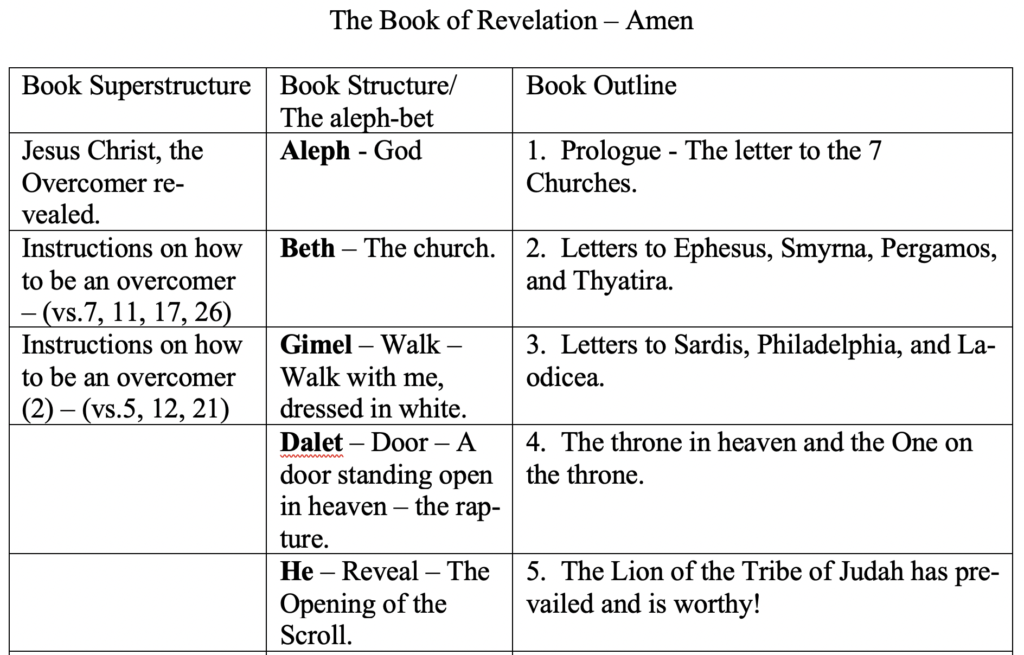
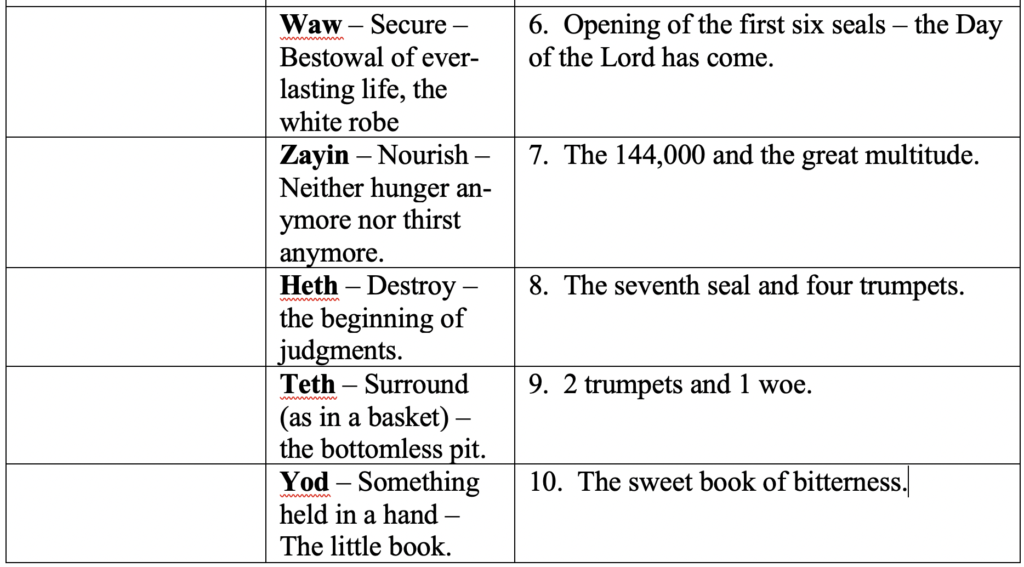
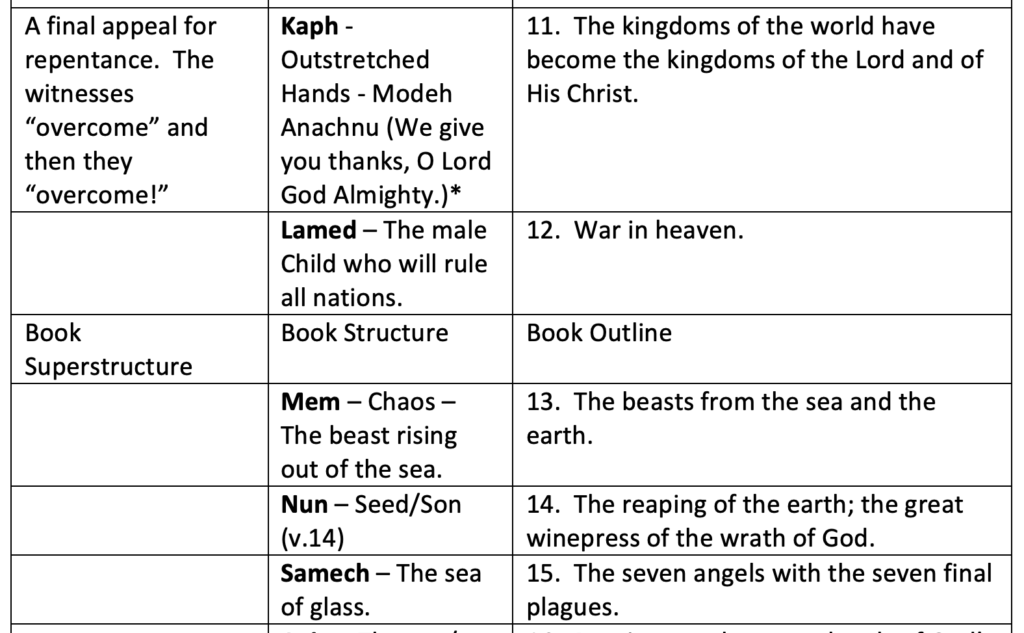
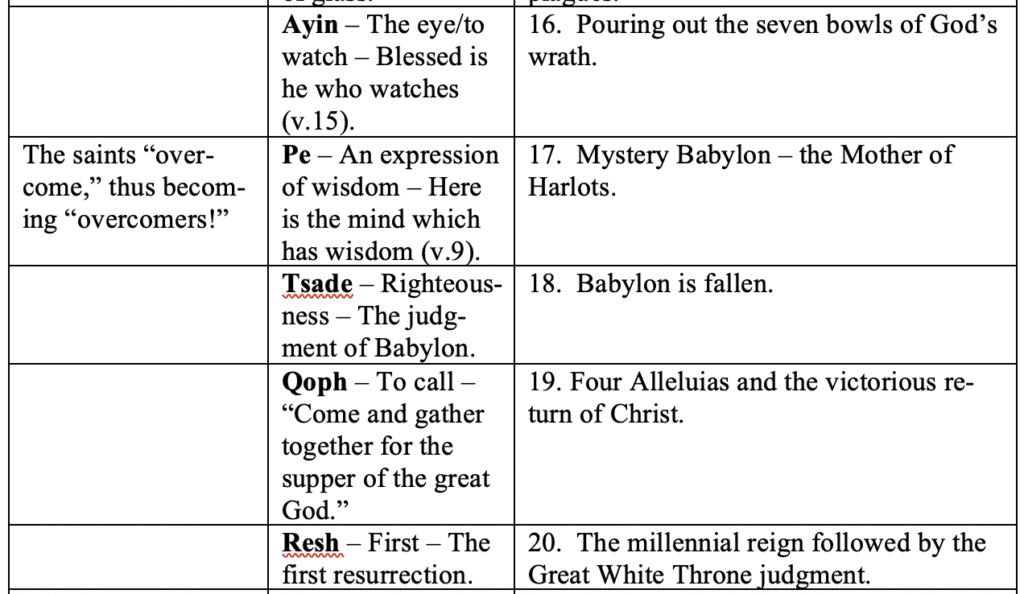
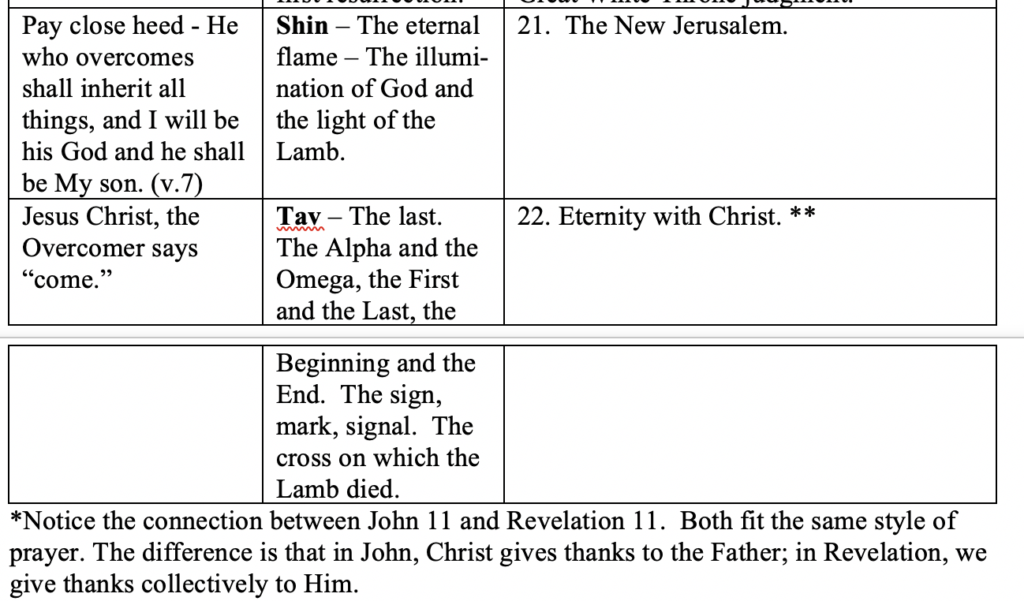
**Revelation ends with 22:21 and not 22:22 – very interesting!
Life application: In the next 404, days we will see the culmination of God’s great plan of redemption as detailed by the Apostle John. This book has been interpreted in many ways, and the book marks a large dividing line between denominations and sects within Christianity. Many heretical views have arisen from an evaluation of the book or are used in an incorrect evaluation of it.
Because there are many ways to approach Revelation, and because of these many opinions on the book’s meaning and fulfillment, it is often ignored, often misused, and often maligned. In the end though, it is a book of absolute truth because it is a part of God’s word. Therefore, we mishandle it or misinterpret it at our own peril – just like all of Scripture.
One of the main dividing lines over the contents of Revelation comes down to one word – Israel. Do you believe that the church has replaced Israel? Does Israel have a future purpose in redemptive history? If one believes that God has rejected Israel, it means that God’s promises and covenant faithfulness cannot be trusted. Is salvation eternal, or can it be lost? National Israel is a template of individual salvation. If God has rejected them, He may also reject you. Is that what God has come to do? Has He come to provide eternal insecurity to His redeemed?
Revelation, and indeed all of the Bible, would say, “No.” What will be presented to you in these next 404 days is based on this idea. Have surety in your salvation. God is faithful, even when you are unfaithful.
Are you ready? Let’s discover the fulfillment of the ages as we explore Revelation!
“He who testifies to these things says, ‘Surely I am coming quickly.’
Amen. Even so, come, Lord Jesus! The grace of our Lord Jesus Christ be with you all. Amen.” Revelation 22:20, 21
Lord God, open our hearts to Your word. Speak to us as we pursue a knowledge of You in it each time we open it. And Lord, convict us that it is right, proper, and necessary to be in it day and night. Help us to put Your word first in our lives because it tells us of Jesus, and because Jesus reveals You to us. May it be so, all the days of our lives. Amen.
